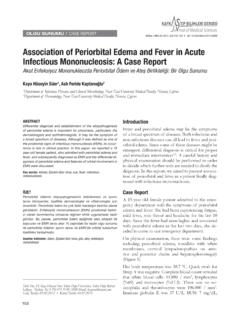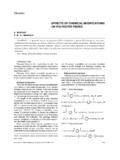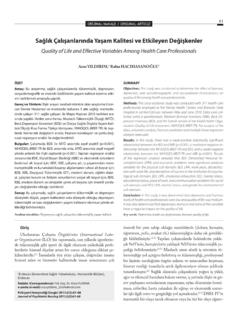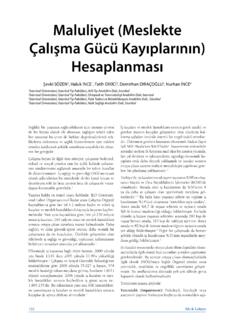Transcription of Flexible flatfoot - JournalAgent
1 North Clin Istanbul 2014;1(1):57-64doi: flatfootAziz Atik1, Selahattin Ozyurek21 Department of Orthopedics and Tarumatology, Balikesir University Faculty of Medicine, Balikesir, Turkey;2 Department of Orthopedics and Traumatology, Aksaz Military Hospital, Marmaris, Mugla, TurkeyABSTRACTW hile being one of the most frequent parental complained deformities, flatfoot does not have a universally ac-cepted description. The reasons of Flexible flatfoot are still on debate, but they must be differentiated from rigid flatfoot which occurs secondary to other pathologies. These children are commonly brought up to a physician without any complaint.
2 It should be kept in mind that the etiology may vary from general soft tissue laxities to intrinsic foot pathologies. Every Flexible flatfoot does not require radiological examination or treatment if there is no complaint. Otherwise further investigation and conservative or surgical treatment may words: Children; flatfoot ; Flexible ; foot problem; pes the term flatfoot (pes planus) is gener-ally defined as a condition which the longitu-dinal arch of the foot collapses, it has not a clinically or radiologically accepted universal definition. Flat-foot which we frequently encounter in routine out-patient practice will be more accurately seen as a re-sult of laxity of ligaments of the foot.
3 However each case of flatfoot is not similar to each other. Staheli divided flatfoot into 2 groups as physiological, and pathological flatfoot [1, 2, 3]. Within this context, Flexible ( Flexible , physiological, and hypermobile) flatfoot should be differentiated from secondary ones which can develop as a consequence of other pathologies. In Flexible flatfoot , medial longitudinal arch of the foot collapses in various degrees during weight-bearing (Figure 1). However during rais-ing up one s body on tiptoe (tiptoe test) foot arch forms again (Figure 2). When weight-bearing forces on feet are relieved this arch can be observed.
4 If the foot is not bearing any weight, still medial longitu-dinal arch is not seen, then it is called rigid (fixed) flatfoot . To differentiate between these two condi-tions easily, Jack s test (great toe is dorisflexed as the plantar fascia tightens) can be used (Figure 3). In this review Flexible flatfoot will be actual incidence of flatfoot in children is not known, it is acknowledged that it is one of the most frequently seen deformites which cause parent s complaints in the outpatient clinic of pe-diatrics. Still, the issue whether Flexible flatfoot is a real deformity is debatable.
5 For instance Staheli et al. [2] performed a study investigating the devel-opment of medial longitudinal arch of the sole, and revealed that flatfoot is generally seen in infants, Received: May 29, 2014 Revised: July 18, 2014 Accepted: July 25, 2014 Online: August 03, 2014 Correspondence: Aziz ATIK. Bal kesir Universitesi Cagis Yerleskesi Tip Fakultesi, Ortopedi ve TravmatolojiAnabilim Dali, 10440 Balikesir, : +90 216 - 566 66 00 e-mail: Copyright 2014 by Istanbul Northern Anatolian Association of Public Hospitals - Available online at ORTHOPEDICS & TRAUMATOLOGY prevalently in children, and occasionally in adults.
6 In their study, Wenger et al.[4] concluded that flex-ible flatfoot is an unavoidable outcome of trying to walk on normal foot bones with loose ligaments. Apparently, most of the time flatfoot does not cause any 90% of the children aged <2 years, an anatomic variation resembling flatfoot can be seen which is due to infantile adipose cushion formation local-ized on the medial part of the foot. Besides toddlers who start to walk can assume a flatfoot posture. In fact they try to walk with their feet resting entirely on the ground so as to maintain a balanced posture. Consequently, they shift their weight-bearing axis to the first or second tarsometatarsal joint which may induce a flatfoot posture.
7 In most of the chil-dren normal longitudinal arch develops at 3-5 years of age (Figure 4), and in only 4% of them flatfoot persists after 10 years of , how is the situation in adults? In nearly 23% of the adult population collapse of the medial longitudinal arch of the foot can be seen [5]. How-ever it is not an isolated entity, and in two thirds of the cases, subtalar complex, hyperflexible ankle joint, and in one-fourths contracture of the triceps surae muscle have been observed [5, 6]. Probably these combined pathologies cause patients com-plaints rather than collapse of the medial longitu-dinal arch per theories have been generated related to the causes of Flexible flatfoot , however precise etiology North Clin Istanbul NCI58 Figure 1.
8 Collapse of the weight-bearing foot. During weight-bearing, disappearance of the medial longitudi-nal arch of the foot is seen. On posterior view, angling of the Achilles tendon (hindfoot valgus) is 2. Tiptoe test. While raising up on tiptoe, re-construction of the medial longitudinal arch collapsed during weight-bearing is 3. Dorsiflexion of the great toe test. When great toe is brought to passive dorsiflexion position, emer-gence of medial longitudinal arch is 4. Schematic demonstration of the arches of the foot. Three foot arches are schematically : Medial longitudinal arkB-C: Lateral longitudinal arkA-B Anterior transvers arkAtik et al.
9 , Flexible flatfoot59dividuals valgus shift of the calcaneus occurs result-ing in loss of support for talar head which assumes a more upright position. Normal arch is lost, the ex-isting pattern shifts to the medial, and foot sole rests more heavily on the ground (Figure 5).When the foot is in supination, bones of the midfoot are locked, and lose much of their capac-ity to move. However joints of the pronated foot become more mobile. During weight-bearing, ever-sion of the heel, and abduction of the forefoot cause collapse of the midfoot, shortening of the longitu-dinal arch , and consequently talar head, and na-vicular tuberosity rest on the floor, and bears the whole weight.
10 With time Achilles tendon shortens, and everts the foot with potential worsening of the deformity, and development of tendon contracture. Many techniques have been used to identify, and define medial longitudinal arch of the foot includ-ing radiological imaging modalities, podoscopic systems which employ mirror to show the contact area beneath the foot, whole toeless footprint analy-sis, arch height, and foot plantar pressure measure-ments To obtain quantitative data, Clarke angle, Chippaux-Smirak Index (CSI), Staheli arch index have been defined. Among them CSI [10, 11] has been reported to have a predictive value above 90 percent [12].















